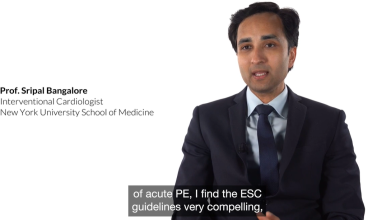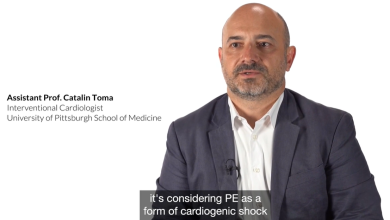In This Section:
Pulmonary Embolism
Venous thromboembolism is a serious disease. Both deep vein thrombosis and pulmonary embolism frequently result in devastating impacts for patients in both the short and the long term. Pulmonary Embolism affects about 1000 out of every 1 million people with 200 of those cases considered to have an intermediate-high and high risk of mortality. Pulmonary Embolism, while preventable, is the 3rd leading cause of cardiovascular death.
As high mortality rates have shown little improvement over the last 20 years, it is clear acute PE patients need to be managed differently. We know that conservative treatment options, as recommended by the guidelines leave thrombus behind in 20-50% of the patients. Literature shows the mortality number on anticoagulation only is still high and the majority of venous clot is lytic-resistant by time of treatment. Thrombolysis comes with significant risk of bleeds.
This section presents key papers, IHR and HR PE case reports and also interviews with the Key Opinion Leaders discussing on how new technologies, like a lytic-free thrombectomy, can transform the treatment of acute Pulmonary Embolism.

Section Advisor
Prof Felix Mahfoud
The Pulmonary Embolism section is supported by

Video
Video
Video
Recent Videos
Broadcast
Felix Mahfoud, Ingo Ahrens, Thomas Cuisset, et al
Video
Michael Piorkowski, Pablo Salinas, Gregor Leibundgut, et al
Video
Maximilian de Bucourt, Ana Viana Tejedor, Ole Jørgen Grøtta, et al
Case Studies
Martinez J, Garcia I, Anniccherico Sánchez F et al. North American Journal of Medical Science. 2016;8:134–142.
Poor H, Serrao G, Grapsa J, et al. J Am Coll Cardiol. 2023;81:283–91.
Chipayo-Gonzales D, Salinas P, Viana-Tejedor A. et al. Eur Heart J. 2023;44:1378.
van den Enden AJM, Meuwese CL, Van Mieghem NM. et al. Eur Heart J. 2023;44:1001.
Mombrun M, Marliot C, Jurj AA, et al. Intensive Care Med. 2023;49:353–4.
Boyle N, Waters DK, McCann J, et al. Am J Respir Crit Care Med. 2023;207(3):e4–5.
Lee C, Stavropoulos SW, Kuo WT. et al. N Engl J Med. 2022;386(22):2149–51.
Clinical publications
Silver MJ, Gibson CM, Giri J, et al. Circ Cardiovasc Interv 2023;16:e013406.
Horowitz JM, Jaber WA, Stegman B, et al. JSCAI 2023;101124
Khandhar S, Jaber W, Bunte MC, et al. JSCAI 2023;101000.
Toma C, Jaber WA, Weinberg MD, et al. Europe PMC 2023;18:1201–12.
Wible BC, Buckley JR, Cho KH, et al. J Vasc Interv Radiol 2019;30:1370–75.
Buckley JR, Wible BC, J Intensive Care Med 2021 16:8850666211036446.
Geller BJ, Adusumalli S, Giri SJ, et al. Vascular Medicine 2020;25:334-40.
Chatterjee S, Chakraborty A, Weinberg I, et al. JAMA 2014;311:2414-21.
Götzinger F, Lauder L, Sharp ASP, et al. Nat Rev Cardiol 2023;12:1-15.
l-Terki H, Gotzmann M, Mahfoud F, et al. Clin Med 2023;12:4006
Klok FA, Piazza G, Sharp ASP, et al. Am Heart J. 2022;251:43–53.
Pike S, Tan K, Burbridge B. et al. Can Assoc Radiol J. 2022;73:581–8.
Zhang H, Li XY, Xia SB, et al. J Vasc Surg Venous Lymphat Disord. 2023;11:351–6.e1.
Hansmann J, Kuei A, Patel MN, et al. J Vasc Surg Venous Lymphat Disord. 2022;10:894–9.
Johnson MS, Spies JB, Scott KT, et al. J Vasc Surg Venous Lymphat Disord. 2023;11:573–85.e6.
Ramakrishnan G, Willie-Permor D, Yei K, et al. J Vasc Surg Venous Lymphat Disord. 2023;11:587–94.e3.
Abou Ali AN, Cherfan P, Zaghloul MS, et al. J Vasc Surg Venous Lymphat Disord. 2022;10:287–92.
Carlon TA, Goldman DT, Marinelli BS, et al. Radiographics. 2022;42:1861–80.
Ismail U, Rowe RA, Cashin J, et al. Sci Rep. 2022;12:5295.
Sedhom R, Megaly M, Elbadawi A, et al. Mayo Clin Proc. 2022;97:1872–82.
Agarwal MA, Dhaliwal JS, Yang EH, et al. Chest. 2023;163:216–25.
Piliero N, Guichard A, Bedague D, et al. JACC Cardiovasc Interv. 2022;15:1994–5.
Bashir R, Foster M, Iskander A, et al. JACC Cardiovasc Interv. 2022;15:2427–36.
Ito R, Yamashita J, Nakajima Y, et al. JACC Cardiovasc Interv. 2023;16:986–7.
Andersen A, Musialek P, Araszkiewicz A, et al. JACC Cardiovasc Interv. 2023;16:623–25.
Bangalore S, Horowitz JM, Beam D, et al. JACC Cardiovasc Interv. 2023;16:958–72.
Wiedenroth CB, Rolf A, Steinhaus K, et al. J Heart Lung Transplant. 2023;42:134–9.
Bikdeli B, Caraballo C, Trujillo-Santos J, et al. JAMA Cardiol. 2022;7:857–65.
Sadeghipour P, Jenab Y, Moosavi J, et al. JAMA Cardiol. 2022;7:1189–97.
Jiménez D, Rodríguez C, León F, et al. Eur Respir J. 2022;59:2100412.
de Jong CMM, Visser C, Bemelmans RHH, et al. Eur Respir J. 2023;61:2300171.
Hobohm L, Sagoschen I, Barco S, et al. Eur Respir J. 2023;61:2200619.
Thienel M, Müller-Reif JB, Zhang Z, et al. Science. 2023;380:178–87.
Jabagi MJ, Bertrand M, Botton J, et al. N Engl J Med. 2023;388:1431–2.
Guidelines
Bangalore S, Horowitz JM, Beam D, et al. JACC Cardiovasc Interv 2023;16:958-72.
Porcaro K, Haines J, Morris S, et al. J Am Coll Cardiol 2019;73:2046.
Khandhar SJ, Mehta M, Cilia L, et al. Catheter Cardiovasc Interv 2020;95:13-18.
Vanni S, Jiménez D, Nazerian P, et al. Thorax 20215;70:333-8.
Ebner M, Pagel CF, Sentler C, et al. 2021;86:25-21.
Jaureguízar A, Jiménez D, Bikdeli B, et al. Chest 2022;161:524-34
Jimenez D, Aujesky D, Díaz G, et al. AM J Respir Crit Care Med 2010;181:983-91.
Meinel F, Nance J, Schoepf U, et al. Am J Med 2015;128:747–59.
Sánchez F, Martinez J, Echezarrata M, et al. N AM J Med Sci 2016;8:134–42.
Guidelines and Consensus
Konstantinides SV, Meyer G, Becattini C, et al. Eur Heart J. 2020;41:543–603.
Pruszczyk P, Klok FA, Kucher N, et al. EuroIntervention. 2022;18:e623–38.
Kanjee Z, Freed JA, Carroll BJ, et al. Ann Intern Med. 2022; 175:1161–69.
Goldberg JB, Giri J, Kobayashi T, et al. Circulation. 2023;147:e628–47.
Humbert M, Kovacs G, Hoeper MM, et al. Eur Heart J. 2022;43:3618–731.
Review Articles
Cueto-Robledo G, Rivera-Sotelo N, Roldan-Valadez E, et al. Curr Probl Cardiol. 2022;47:101294.
Kochar A, Bergmark BA. Eur Heart J Acute Cardiovasc Care. 2022;11:721–7.
Inman BL, Long B. Ann Emerg Med. 2023;81:580–3.
Ross C, Kumar R, Pelland-Marcotte MC, et al. Chest. 2022;161:791–802.
Harvey JJ, Huang S, Uberoi R. Cochrane Database Syst Rev. 2022;8:CD013083.
Warren RE, Dhruva SS, Kinard M, et al. JAMA Intern Med. 2023;183:271–2.
Rezende SM. Lancet Haematol. 2023;10:e11.
Freund Y, Cohen-Aubart F, Bloom B. et al. JAMA. 2022;328:1336–45.
Walter K. JAMA. 2023;329(1):104.
Systematic Analysis
Ismayl M, Machanahalli Balakrishna A, et al. Am J Cardiol. 2022;178:154–62.
Alshaqaq HM, Al-Sharydah AM, Alshahrani MS, et al. J Intensive Care Med. 2023;38:491–510.
Mathew D, Kim J, Kosuru BP, et al. Sci Rep. 2023;13:7169.
Fernando SM, Tran A, Cheng W, et al. Chest. 2022;161:418–28.
Jain N, Sheikh MA, Bajaj D, et al. JACC Cardiovasc Interv. 2023;16:976–83.
Le Roux PY, Schafer WM, Blanc-Beguin F, et al. Clin Nucl Med. 2023;48:8–17.
Chopard R, Nielsen P, Ius F, Cebotari S, et al. Eur Respir J. 2022;60:2102977.


















